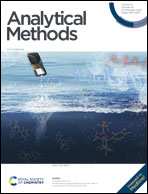Reactive argon-plasma activation of screen-printed carbon electrodes for highly selective dopamine determination†
Abstract
Dopamine (DA) deficiency has been linked to several psychiatric disorders. Electrochemical determination of the level of DA suffers from abundant ascorbic acid (AA) and uric acid (UA) in body fluids. In this work, a facile argon (Ar) plasma treatment was utilized to enhance the electrocatalytic reactivity of screen-printed carbon electrodes (SPCEs) for selective DA detection. Surface characterization of the Ar-treated SCPEs verified that the carbon paste binders were successfully removed and single-bonded oxygenated moieties (–OH and C–O–C) were generated. Interestingly, the sharper D* and D′′ Raman interbands were new key evidence of a higher exposure of carbon defect sites. Electrochemical studies further revealed that the Ar-treated SPCEs possessed faster heterogeneous electron-transfer rates, larger electroactive surface areas, and much higher conductivity when compared with untreated electrodes. As a result, the oxidation potentials of AA, DA, and UA in the mixture could be well-resolved and the current responses were significantly increased. The selective determination of DA in the presence of AA and UA by differential pulse voltammetry gave two linear responses with the limit of detection of 0.27 μM (0.15–10 μM range). Moreover, this Ar-treated SPCE had high reproducibility and good storage stability. These results suggest that Ar-plasma treatment could be a promising method to enhance the electrocatalytic properties of SPCEs for the detection of biomolecules.

- This article is part of the themed collection: Analytical Methods HOT Articles 2022


 Please wait while we load your content...
Please wait while we load your content...